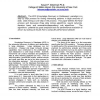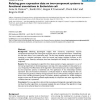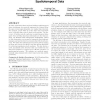391 search results - page 39 / 79 » Using transposition for pattern discovery from microarray da... |
CMG
2001
13 years 10 months ago
2001
- The KDD (Knowledge Discovery in Databases) paradigm is a step by step process for finding interesting patterns in large amounts of data. Data mining is one step in the process. T...
KDD
2005
ACM
14 years 9 months ago
2005
ACM
The problem of finding frequent patterns from graph-based datasets is an important one that finds applications in drug discovery, protein structure analysis, XML querying, and soc...
BMCBI
2008
2008
Relating gene expression data on two-component systems to functional annotations in Escherichia coli
13 years 8 months ago
Background: Obtaining physiological insights from microarray experiments requires computational techniques that relate gene expression data to functional information. Traditionall...
KDD
1995
ACM
14 years 6 days ago
1995
ACM
The information age is characterizedby a rapid growth in the amountof information availablein electronicmedia. Traditional data handling methods are not adequate to cope with this...
KDD
2004
ACM
14 years 9 months ago
2004
ACM
In many applications that track and analyze spatiotemporal data, movements obey periodic patterns; the objects follow the same routes (approximately) over regular time intervals. ...



